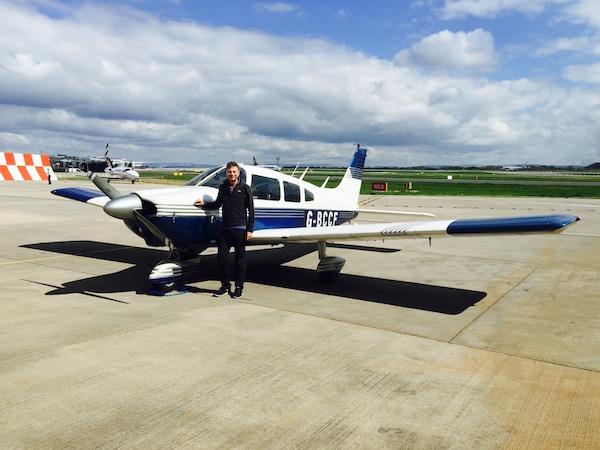The last time I flew solo was in April 2015. I had lost my appetite to fly to a different UK airfield just to eat a bacon sandwich, refuel and return. On reflection the long term goal I held was to obtain my UK private pilots licence. After I had that goal in the bag in April 2011, to keep my interest alive, I would have needed to progress up to being able to navigate above the clouds and to possibly learn to fly multi engined aircraft. I didn’t have the funds to commence all of that training.
The reason I mention this is because of the lessons that learning to fly taught me. Flying a single engined aircraft inherently carries the risk of losing power whilst in the air. Much of demonstrating that you are a competent pilot revolves around risk assessment and the procedures you learn by heart just in case.
Loss of Power
Here’s the procedure for what to do if the propellor stops spinning. At a normal altitude of around 2500 ft you can stay aloft about 2 minutes only. You need to know instinctively what to do.
- Turn downwind. Flying with the wind can increase your glide range and keep you aloft longer. Smoke and flag direction is useful in establishing wind direction. Cows should be looking towards you, they always face the wind.
- In the aircraft I flew the optimum glide distance is achieved at 73 knots. Any faster, you will reach the ground more quickly. Any slower and it cuts down on the distance you are able to fly. You may not reach a suitable place to land. Quickly raise or lower the nose to achieve exactly 73 knots.
- Now pick a suitable field. Level as possible, not ploughed, treeless threshold if possible, look out for power cables. Golf fairways are our friends here. It should be to your side as you will be approaching up wind having done a 180 degree turn.
Only now check for the cause of the power loss.
- FUEL SELECTOR – switch fuel tanks
- ELECTRIC FUEL PUMP – on
- FUEL MIXTURE – rich
- CARBURETTOR HEAT – on
- GAUGES – check for indication of power loss
- PRIMER – check locked
- FUEL PRESSURE – if none indicated, check position to ensure it is on a tank containing fuel.
- IGNITION – try the starter motor. 3 attempts.
when power is restored
- CARBORETTOR HEAT – off
- ELECTRIC FUEL PUMP – off
- POWER – full
- ALTITUDE – climb
if power isn’t restored prepare for power off landing
- MAYDAY CALL – (a procedure in itself. mayday, mayday, mayday…..)
- SQUAWK – transmit 7700 (seven seven going to heaven) so air traffic control can identify your exact position
- FLAPS – full only once you know you can reach your selected field
- AIRSPEED – 55 knots
- FUEL – off
- IGNITION – off
- MASTER SWITCH – off. kills all electrical power.
- LAP STRAP – tight
- DOOR – cracked open
I carried out the drill many times and was regularly tested on it. Thankfully I never needed to use it in a real emergency. I did experience an engine coughing, spluttering and threatening to cut out once, but changing the fuel tank selector on that occasion was all that was necessary.
Preparation
There are many parallels to be drawn between flying and investing. Having procedures drilled in beforehand, for when the markets experience a loss of upward momentum is essential. There is no point in reacting badly after we have seen a market fall. We should have been monitoring its progress regularly along the way. Exactly what we do next should have been decided upon and learned long ago. We should have been regularly testing ourselves along the way to ensure we won’t just panic and throw our procedures out of the window.
What did I do when my engine spluttered? What I was taught to do, proceed directly to the nearest airfield. It wasn’t an emergency, but sticking to my original flight plan could have turned it into one.
A bit of physics
Here are the forces acting on a typical aircraft.

Similar forces act on any share or indeed on markets as a whole. In fact on any investment.
- Thrust is the forward motion of a share which is usually powered by increasing profits. Profits rising spin the propellor faster, failing profits spins the propellor more slowly. Loss of profits leads to a huge drop in altitude as drag takes over.
- Drag is usually down to debt which needs to be repaid before profits are made. If the debts are too large, it doesn’t matter how fast the propellor is spinning, the investment will never clear the ground. Drag can also be caused by government intervention. Today trade wars have become the new Cold War. Companies are being held back whilst geopolitical groups fight it out amongst themselves.
- Lift & Weight in an aircraft dictate cruising altitude when thrust and drag are balanced. Add more lift the plane rises and more weight the plane falls. In investment the balance is the current share price. Additional buyers lift the share price, additional sellers weigh the price down. It’s just supply and demand.
recent valuation falls
We have recently experienced a slight loss of investment altitude. Sellers increased as Governments kicked-off. Indicators suggest economies could be running into recession, so central banks globally have been cutting interest rates aggressively, which has spooked investors who are reacting badly to media exaggerated bad news.
Market returns are not correlated to current economic conditions.
Markets look ahead to what comes next. By the time we enter a recession markets are usually pricing in a recovery. When economies are firing on all four cylinders, markets are already starting to price in that these favourable conditions won’t last.
We have lost 3.5% of our highest ever altitude. We will continue to monitor developments closely. Currently the engine has given a splutter, it’s normal for markets to experience this in summer. Rest assured. We have our power loss procedures learned off by heart. Should the situation develop further we have procedures in place to ensure our safety.
There are old pilots.
There are bold pilots.
There are no old, bold pilots.


As ever, an interesting insight into the complicated world of investing, which is why us numpties leave it to you experts.
What could hold our share values back? Nothing other than old fashioned greed……
That was a great way of explaining clearly where we are in this year of uncertainty and how you understand what needs to be done. I always knew there would be a good reason for you to learn to fly other than a bacon butty.Steady as she goes H .
Hi Howard
I enjoyed reading this blog in the light of our discussion the other day and it explained our investments in an easy to understand way.
I put my slight panic down to viewing my investment over just a few days and not over a longer term. this was due to me not using the relatively new ‘nucleus go’ portfolio information fully. I now understand it a lot better, so thankyou for explaining it, and putting my mind at rest.
Geoffrey, I disappoint Howard on a regular basis by not reviewing investments as frequently as I should, but my reasoning is that i would worry about the downs more than I should!
And Howard, having read the potential downsides of flying, I’m glad I stuck to the original plan of buying a narrowboat – far less to go wrong.
Howard – an excellent and useful/simple explanation/analogy, as ever. I trust you will become an old pilot…